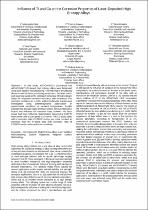 ResearchSpace
ResearchSpace
Influence of Ti and Cu on the corrosion properties of laser-deposited high entropy alloys
JavaScript is disabled for your browser. Some features of this site may not work without it.
- ResearchSpace
- →
- Research Publications/Outputs
- →
- Journal Articles
- →
- View Item
| dc.contributor.author |
Dada, M

|
|
| dc.contributor.author |
Popoola, P

|
|
| dc.contributor.author |
Mathe, Ntombizodwa R

|
|
| dc.contributor.author |
Pityana, Sisa L

|
|
| dc.contributor.author |
Adeosun, S

|
|
| dc.contributor.author |
Dlamini, Thembisile P

|
|
| dc.contributor.author |
Aramide, O

|
|
| dc.date.accessioned | 2022-02-07T06:59:06Z | |
| dc.date.available | 2022-02-07T06:59:06Z | |
| dc.date.issued | 2021-11 | |
| dc.identifier.citation | Dada, M., Popoola, P., Mathe, N.R., Pityana, S.L., Adeosun, S., Dlamini, T.P. & Aramide, O. 2021. Influence of Ti and Cu on the corrosion properties of laser-deposited high entropy alloys. http://hdl.handle.net/10204/12257 . | en_ZA |
| dc.identifier.uri | http://hdl.handle.net/10204/12257 | |
| dc.description.abstract | In this study, AlCoCrFeNiCu (Cu-based) and AlCoCrFeNiTi (Ti-based) high entropy alloys were fabricated using laser additive manufacturing. The influence of the alloying elements and the laser processing parameters, the laser power and scanning speed on the corrosion behaviour of high entropy alloys for improved corrosion resistance were examined. The corrosion resistance in 1 mol/L sodium hydroxide solution was investigated using potentiodynamic polarization in experimental conditions at ambient temperature. Results indicate that the scan speed and laser power are two interactive factors that influence the corrosion rates, however, the laser power had more influence. Optimization occurred at 1400 W laser power and a scan speed of 10 mm/s. The Cu-based alloy with a corrosion rate of 0.00197 mm/yr was more resistant to corrosion than the Ti-based alloy with corrosion rates of 0.002635 mm/yr under optimum conditions. | en_US |
| dc.format | Fulltext | en_US |
| dc.language.iso | en | en_US |
| dc.relation.uri | https://site.rapdasa.org/wp-content/uploads/2021/11/2021-RAPDASA-BOOKLET-Draft-3-electronic-with-links-1.pdf | en_US |
| dc.source | The 22nd Annual International RAPDASA Conference, CSIR International Convention Centre, Pretoria, South Africa, 3-5 November 2021 | en_US |
| dc.subject | Corrosion rate | en_US |
| dc.subject | High entropy alloys | en_US |
| dc.subject | Laser additive manufacturing | en_US |
| dc.subject | Sodium hydroxide | en_US |
| dc.subject | Response surface methodology | en_US |
| dc.title | Influence of Ti and Cu on the corrosion properties of laser-deposited high entropy alloys | en_US |
| dc.type | Conference Presentation | en_US |
| dc.description.pages | 6 | en_US |
| dc.description.note | Paper presented at the 22nd Annual International RAPDASA Conference, CSIR International Convention Centre, Pretoria, South Africa, 3-5 November 2021 | en_US |
| dc.description.cluster | Manufacturing | en_US |
| dc.description.impactarea | Laser Enabled Manufacturing | en_US |
| dc.identifier.apacitation | Dada, M., Popoola, P., Mathe, N. R., Pityana, S. L., Adeosun, S., Dlamini, T. P., & Aramide, O. (2021). Influence of Ti and Cu on the corrosion properties of laser-deposited high entropy alloys. http://hdl.handle.net/10204/12257 | en_ZA |
| dc.identifier.chicagocitation | Dada, M, P Popoola, Ntombizodwa R Mathe, Sisa L Pityana, S Adeosun, Thembisile P Dlamini, and O Aramide. "Influence of Ti and Cu on the corrosion properties of laser-deposited high entropy alloys." <i>The 22nd Annual International RAPDASA Conference, CSIR International Convention Centre, Pretoria, South Africa, 3-5 November 2021</i> (2021): http://hdl.handle.net/10204/12257 | en_ZA |
| dc.identifier.vancouvercitation | Dada M, Popoola P, Mathe NR, Pityana SL, Adeosun S, Dlamini TP, et al, Influence of Ti and Cu on the corrosion properties of laser-deposited high entropy alloys; 2021. http://hdl.handle.net/10204/12257 . | en_ZA |
| dc.identifier.ris | TY - Conference Presentation AU - Dada, M AU - Popoola, P AU - Mathe, Ntombizodwa R AU - Pityana, Sisa L AU - Adeosun, S AU - Dlamini, Thembisile P AU - Aramide, O AB - In this study, AlCoCrFeNiCu (Cu-based) and AlCoCrFeNiTi (Ti-based) high entropy alloys were fabricated using laser additive manufacturing. The influence of the alloying elements and the laser processing parameters, the laser power and scanning speed on the corrosion behaviour of high entropy alloys for improved corrosion resistance were examined. The corrosion resistance in 1 mol/L sodium hydroxide solution was investigated using potentiodynamic polarization in experimental conditions at ambient temperature. Results indicate that the scan speed and laser power are two interactive factors that influence the corrosion rates, however, the laser power had more influence. Optimization occurred at 1400 W laser power and a scan speed of 10 mm/s. The Cu-based alloy with a corrosion rate of 0.00197 mm/yr was more resistant to corrosion than the Ti-based alloy with corrosion rates of 0.002635 mm/yr under optimum conditions. DA - 2021-11 DB - ResearchSpace DP - CSIR J1 - The 22nd Annual International RAPDASA Conference, CSIR International Convention Centre, Pretoria, South Africa, 3-5 November 2021 KW - Corrosion rate KW - High entropy alloys KW - Laser additive manufacturing KW - Sodium hydroxide KW - Response surface methodology LK - https://researchspace.csir.co.za PY - 2021 T1 - Influence of Ti and Cu on the corrosion properties of laser-deposited high entropy alloys TI - Influence of Ti and Cu on the corrosion properties of laser-deposited high entropy alloys UR - http://hdl.handle.net/10204/12257 ER - | en_ZA |
| dc.identifier.worklist | 25326 | en_US |





